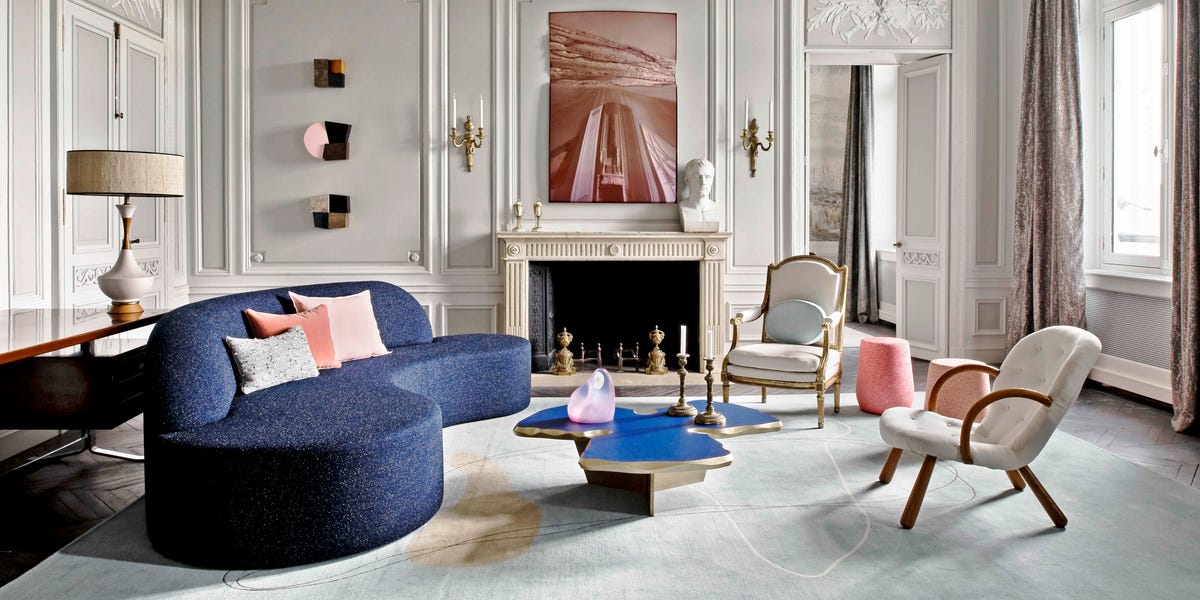Curved Sofas Have Deep-Rooted Design Legacy
The curved sofa has a long history in interior design, with its origins tracing back to the 1950s when Vladimir Kagan introduced his iconic Serpentine Sofa. However, the concept of curved seating dates even further back, with subtle curves appearing during the Art Deco era of the 1920s and 1930s. The design made a strong comeback during the 1980s, particularly with the Schiaparelli Sofa from Michael Taylor. This rich heritage is one reason designers consider the curved sofa to be timeless rather than just a passing trend.
Interior designer Jeffry Weisman from San Francisco notes that the elegance of the Schiaparelli sofa from the 1980s has remained popular, and he has designed many curved sofas for his own projects. “Not every room has the space or call for a curved sofa, but a surprisingly high number do,” he says. The historical significance of curved sofas gives them a unique place in modern interiors, allowing designers to reinterpret classic designs for contemporary spaces.
Curved Sofas Define Flow in Large or Challenging Spaces
Many designers view curved sofas as practical solutions to specific decorating challenges. Catherine Olasky uses them to resolve asymmetrical seating arrangements, create comfort in bay windows, or mirror the curve of oval-shaped tables. Lisa Mende from Charlotte, NC, notes that curved sofas can help define a room’s flow when there is no natural focal point, especially in large or open-concept spaces.
Judith Heimowitz from Scarsdale, NY, recently installed a pair of serpentine designs facing each other in a large room without a fireplace or television. She explains that the soft, organic lines created seamless flow between different zones like a piano, bar, and card table. Laura Jenkins from Atlanta warns that curved sofas typically take up more space than straight styles, so they work best in rooms large enough for them to “float” away from the wall, allowing for circulation around them.
Tom Riker from Chicago-based James Thomas emphasizes that curved sofas are most effective when allowed to float in a room and supported by equally strong pieces. This approach helps maintain balance and functionality in larger spaces.
Curved Sofas Encourage Conversation
Designers agree that curved sofas are not only visually striking but also encourage conversation and social interaction. Lindsay Olson from Newport Beach, CA, says the curvilinear design brings a sense of movement, softness, and invitation to a room. “I select them for clients who crave a living room that feels both luxurious and approachable,” she explains.
Curved sofas can comfortably seat more people during gatherings, making them ideal for parties. Jeffry Weisman adds that no one wants to sit on the center cushion of a three-seat sofa, but four or five guests are happy to perch together on a curved sofa. Kristin Harrison from McLean, VA, shares that using a curved sofa in a sitting room transformed the space, making it feel cozier than a standard sofa would have.
Amanda Martocchio from New Canaan, CT, agrees that slightly curved sofas give a more relaxed feel to seating arrangements, inviting less formal gatherings. These design elements make curved sofas ideal for creating welcoming and interactive living spaces.
Curved Sofas Add Soft Contrast
Beyond their functional benefits, designers appreciate how curved sofas contrast with linear architectural elements, creating a dynamic and organic effect. Kerith Flynn from Long Island, NY, describes curved silhouettes as undeniably chic, sculptural, and a bit sexy. “They allow us to break up all the hard angles and boxy layouts we often encounter,” she says.
Britany Simon from Scottsdale, AZ, emphasizes the importance of balance. “You don’t want everything in the room to be curved. Mixing in more structured, angular pieces helps ground the look and keeps the space feeling refined and intentional.” Tom Riker adds that introducing non-curvilinear pieces ensures the space doesn’t become overly soft or unstructured.
Curved Sofas Are Design Chameleons
One of the key reasons designers frequently choose curved sofas is their versatility across different decorating styles and settings. Christina Roughan from Connecticut notes that the graceful arc of Kagan’s original design embodies a modern sensibility while harmonizing with traditional pieces. Palmoma Contreras from Houston agrees that curved sofas offer a juxtaposition similar to abstract paintings or contemporary light fixtures.
While most commonly used in living rooms, designers also praise curved sofas for their use in other areas of the home. Kerith Flynn from Long Island highlights that curved sofas bring drama and glamour to intimate settings, such as primary bedrooms or bar areas. Upholstered in rich velvet or bold colors, they add a stylish lounging element to any space.
When to Avoid Using a Curved Sofa
Despite their popularity, designers caution that curved sofas may not suit every situation. If lounging is your top priority, a curved silhouette might not be the right choice. Jeanne Barber from West Hartford notes that the curve can interfere with relaxing on the couch, as it makes it harder to put your feet up or lie lengthwise. Cynthia Ferguson from Toronto adds that the tight cushions on curved sofas are less conducive to long hours of comfort.
Another consideration is space. Designers emphasize that ample square footage is needed for most curved sofas to work effectively. Lindsay Olson from Newport Beach advises that curved sofas shine brightest in rooms with generous proportions where their silhouette can be fully appreciated. Hillary Matt from New York City agrees, stating that the design needs to float so it can be appreciated from all angles.
Finally, designers recommend avoiding curved sofas simply because they are trending on social media. Lindsay Olson suggests choosing a curved sofa only if it genuinely resonates with your lifestyle and home architecture. Adding custom details can also help personalize the design to reflect your taste. Brad Ramsey from Nashville notes that what makes curved sofas feel current depends on factors like fabric, scale, color, and details such as fringe or trim.







